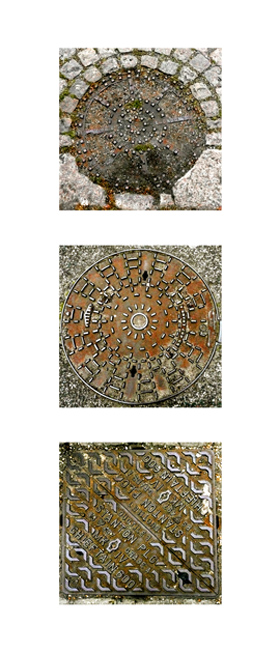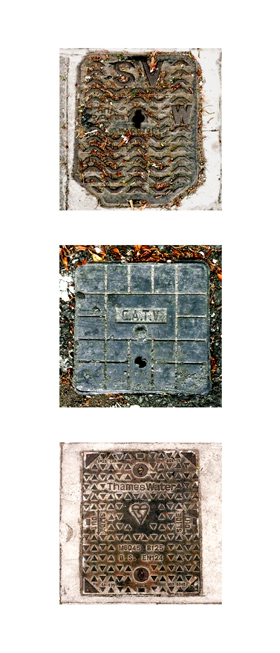London Underfoot Triptychs


left: London Underfoot – Triptych #3; right: London Underfoot – Triptych #7
The London Underfoot – Triptychs are now up, with two out of the seven shown above. This series of prints are a variation on the smaller London Underfoot prints which I posted earlier this week. And, as you can see, these are in a non-traditional vertical format for a triptych.
UPDATE: Please visit the ARKEO series in my new GALLERY to see all seven. All are archival inkjet prints, this time on Hahnemuhle PhotoRag paper.
January 22, 2011 in Arkeo, Digital printmaking, Printworks by Marja-Leena
Hi Marija-Leena
I love this post.
I am a Londoner born, and bred there and in Essex.
Since a small child have been facinated by the drain covers and water hole covers and also the lovely wooden covers that are outside the old pubs that open like french doors, the one’s where they drop the beer barrels down into the cellars, I have so many photo’s of them both from London and Essex.
I wonder who designed them, they could of left them plain but somewhere along the line they decided to make them a thing of beauty, the foundries must have muttered everytime the designs got more intricate.
I love what you have done with your photographs, I always thought they were beautiful now I know they are beautiful.
I asked Norman (husband) what he called the covers and he called them drain furniture, whether that is an Essex term or not I don’t know, I will ask my dad – A true Londoner and let you know if it’s any different.
~ Julie
I much prefer the single prints. I think because the subjects nearly always occur singly ‘in nature’ and that is very much how I conceptualise them. Perhaps a failure on my part to abstract the finished works from the subject/inspiration.
These are really impressive. During my last visit to London I started taking pictures of these drain covers but I got too distracted by weird graffiti to focus on the gems under my feet.
I checked the dictionary on triptych. Most of it was what you’d expect after which was appended: esp. an altarpiece consisting of a central panel with two hinged flanking panels half its width that can be folded inwards to cover it completely. Leaving aside why one would find it necessary to cover up a work of art I occupied myself (I’m at a brief impasse with the novel) imagining what place of worship would best be adorned by your secular triptychs. Cars long ago replaced the Church of England as a subject of veneration but the fact that cars trundle over street furniture doesn’t fit in with the idea of worship, unless the triptychs occupy some sort of sacrificial role.
Although come to think of it there’s a case for saying the draincovers endure the cars and, more particularly, outlast them. That’s it. I see your triptychs playing a part in the Church of Old Age, an organisation in which I have something of a vested interest.
On an aesthetic note, reducing your photos causes the moulded detail on the covers to coalesce into a texture and reminds me of a form of jewellery based on primitive artwork. I take Jean’s point (above) that covers normally have an individual life but I think that in their reduced state they become something else entirely and the two versions have a legitimate co-existence
Julie, thanks so much for your kind words and for the details regarding your own interest. In our infrequent visits to Europe, including England, we are so very captivated by the old architecture and designs, whereas visitors from ‘the old country’ love the modernity of our young city of Vancouver.
Jean, that’s interesting! I think the small prints translated so much better onto the blog than the larger triptych pieces. The latter look much better in reality and are quite stunning all side by side on a wall and have had great responses. But they do have a different feel to them, less like historical prints and more conceptual and design oriented.
Sabine, welcome and thank you! Graffiti is certainly yet another interesting subject for photography, reflecting the modern city rather than its history.
BB, I chuckled over your wonderful twists in interpretion on the modern secular triptych and I suspect in my subconscious there are some truths there. Certainly I’m aware of the religious altarpieces (I love the early north European ones) as well as some modern art works based on that design.
Your observations on the effect of reducing the images are very astute. Some of the patterns, even before reduction, made me think of eastern carpet designs and indeed jewelry as you mention. I’m so pleased that you noticed these and the ‘co-existence’ of the two versions, thank you!
My immediate reaction is that I much prefer the triptych form to the single ones. I think that I would also prefer a multiple collection like this too. My preferred presentation of a single cover is as in the Mark Boyle family pieces such as shown on http://www.thecentreofattention.org/exhibitions/boylefamily.html
If the objects are to be taken out of context, then I like the idea of them being seen as a species – rather like a collection of butterflies for study. But that’s just me.
Interesting thoughts, Olga! And thanks for the Boyle link, I remember them, possibly from an earlier discussion we’ve had. When I took these photos, I didn’t know I’d be making this series of prints. There were times as I was working on them that I wished I could go back and re-photograph some of these. It actually happens often because I collect so many photos for my image library, not knowing which may become part of art works later and how they might be incorporated. Of course, digital manipulation helps a lot.
Yes, it is difficult when visiting somewhere to know what to photograph. In 1997 I went to Venice for the first time and loved the doorbells. I took lots of quick photos of them, but have not really come up with any way of using them that feels right for me – however, I love looking at them from time to time. It is great that you have found at least two ways of using your London Underfoot pix, and I hope you get an opportunity to return to take more sometime.
Olga, if I could go to Venice again, I’d now know so much better what photos I’d take. We went in 1983 to Italy but I was not quite such a photographer then. As for these images, look for them incorporated into the next two prints that I’ll upload sometime soon!
Oh, I like these very much. Street iconography around the world is a fascinating vocabulary of images.
mb, I’m glad, and yes! Sometimes I think I need to travel more, heh!